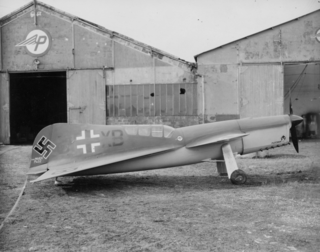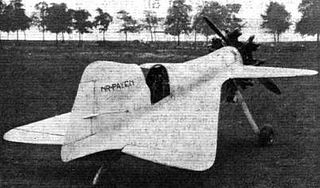
The de Havilland DH.87 Hornet Moth is a single-engined cabin biplane designed by the de Havilland Aircraft Company in 1934 as a potential replacement for its highly successful de Havilland Tiger Moth trainer. Although its side-by-side two-seat cabin made it closer in configuration to the modern aircraft that military trainee pilots would later fly, there was no interest from the RAF and the aircraft was put into production for private buyers.

The British Aerospace Jetstream 41 is a turboprop-powered feederliner and regional airliner, designed by British Aerospace as a stretched version of the popular Jetstream 31. Intended to compete directly with 30-seat aircraft like the Embraer Brasilia, Dornier 328 and Saab 340, the new design eventually accommodated 29 passengers in a two-by-one arrangement like the Jetstream 31. Eastern Airways of the UK is the biggest operator of Jetstream 41s in the world, with 14 in the fleet.

The MB.200 was a French bomber aircraft of the 1930s designed and built by Societé des Avions Marcel Bloch. A twin-engined high-winged monoplane with a fixed undercarriage, over 200 MB.200s were built for the French Air Force, and the type was also licence built by Czechoslovakia, but it soon became obsolete, and was largely phased out by the start of the Second World War.

The Bloch MB.170 and its derivatives were French reconnaissance bombers designed and built shortly before the Second World War. They were the best aircraft of this type available to the Armée de l'Air at the outbreak of the war, with speed, altitude and manoeuvrability that allowed them to evade interception by the German fighters. Although the aircraft could have been in service by 1937, debate over what role to give the aircraft delayed deliveries until 1940.

The LFG Roland C.II, usually known as the Walfisch (Whale), was an advanced German reconnaissance aircraft of World War I. It was manufactured by Luft-Fahrzeug-Gesellschaft G.m.b.H.

The Blériot 165 was a French airliner of the 1920s. It was a four-engined biplane, a final development in the family of designs that began with the Blériot 115. Two were built for Air Union to replace the Farman Goliath on their Paris–London route and were christened Leonardo da Vinci and Octave Chanute. The airline found that it preferred the Lioré et Olivier LeO 21s that it had ordered alongside this aircraft, meaning that no further examples were produced.

The Caudron C.690 was single-seat training aircraft developed in France in the late 1930s to train fighter pilots to handle high-performance aircraft. It was a conventional low-wing cantilever monoplane that bore a strong resemblance to designer Marcel Riffard's racer designs of the same period. Caudron attempted to attract overseas sales for the aircraft, but this resulted in orders for only two machines - one from Japan, and the other from the USSR. In the meantime, the first of two prototypes was destroyed in a crash that killed René Paulhan, Caudron's chief test pilot.

The Roland D.VI was a German fighter aircraft built at the end of World War I. It lost a fly-off to the Fokker D.VII, but production went ahead anyway as insurance against problems with the Fokker.

The Sud-Est SE.200 Amphitrite was a flying boat airliner built in France in the late 1930s, originally developed as the Lioré et Olivier LeO H-49 before the nationalisation of the French aircraft industry. It was a large, six-engine design with a high-set cantilever monoplane wing, and twin tails. It was developed in response to a French air ministry specification of 1936 for a transatlantic airliner for Air France with a range of 6,000 km (3,700 mi) and capacity for 20 passengers and 500 kg of cargo. Designs were submitted by Latécoère, Lioré et Olivier and by Potez-CAMS as the Laté 631, LeO H.49 and the Potez-CAMS 161 respectively, and examples of all designs were approved for construction. A large mock-up, resting on simulated water, was displayed at the 1938 Salon de l'Aéronautique.

The Potez 53 was a French low-wing enclosed cockpit single-seat cantilever monoplane racing aircraft built by Potez to specifically to compete in the 1933 Coupe Deutsch de la Meurthe race, which it won outright.

The Ago Ao 192 Kurier was a small German twin-engined aircraft designed and built by AGO Flugzeugwerke in the 1930s. A small production run of six aircraft followed three prototypes, these being used as transports.

The Fokker T.IX was a Dutch twin-engined bomber designed and built by Fokker for the Royal Netherlands East Indies Army Air Force as a replacement for their obsolescent Martin-built bombers.

The Payen Pa 49 Katy was a small experimental French turbojet powered tailless aircraft, designed by Nicolas Roland Payen, and first flown in 1954. It was the first French aircraft of this kind and the smallest jet aircraft of its day.
The Stampe et Vertongen RSV.22 was a training biplane produced in Belgium in the 1920s.

The Payen PA-22 was a French experimental aircraft designed by Nicolas Roland Payen.

The Payen Arbalète was a small, pusher configuration, experimental French tailless aircraft, designed by Nicolas Roland Payen, and first flown in 1965.
The Payen Pa.47 Plein Air was a French two seat, high wing single engine tourer, which first flew in 1949. Only one was built.
Nicolas Roland Payen was a French aeronautical engineer. He has been described as the originator of the delta wing.
The Caudron C.860 was a single engine, single seat monoplane ordered by the French government as a long distance communications aircraft. First flown in 1938, it was also expected to set speed and altitude records but the outbreak of World War II ended developments.

The Payen Pa.101 was an experimental aircraft designed by Nicolas Roland Payen in the 1930s.
















